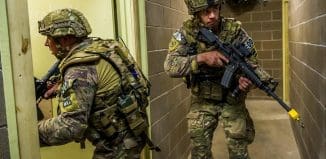Military technology is stranger than fiction
This post is also available in:  עברית (Hebrew)
עברית (Hebrew)
 They say that need is the father of invention, but an extensive article on the subject of the future battlefield published recently in the Daily Mail points out that even if that’s true, it’s more accurate to say that war is the main incentive for pushing humanity to modern and scientific ingenuity in every age throughout history. A flight to space, superglue and micro waves – all these originated from between the battle trenches. If in the past scientists have focused on developing ways of making it easier for soldiers to fight effectively, today the main purpose is to keep the soldiers alive and to bring them home safe as soon as possible.
They say that need is the father of invention, but an extensive article on the subject of the future battlefield published recently in the Daily Mail points out that even if that’s true, it’s more accurate to say that war is the main incentive for pushing humanity to modern and scientific ingenuity in every age throughout history. A flight to space, superglue and micro waves – all these originated from between the battle trenches. If in the past scientists have focused on developing ways of making it easier for soldiers to fight effectively, today the main purpose is to keep the soldiers alive and to bring them home safe as soon as possible.
A first example of such development is the virtual reality trainings which are gaining more respect in armies all around the world as valuable combat training. After putting on a special helmet, soldiers can practice fighting in different scenarios at different levels of difficulty. Virtual reality surrounds them with a 3D environment as practice for the real battlefield while saving costs of pyrotechnics. There are even more advanced simulation systems, which the army of Poland uses, that whenever a soldier is hit in the simulation, uses an annoying but harmless electric current as notice of the hit.
Another technological development is the exoskeleton suit that amplifies physical force by dozens. This development isn’t new, as in the 1960s it already existed, giving the soldier 25 times more than his normal strength. However, fifty years ago the exoskeleton was not operated since it had so major malfunctions, such as lack of ability to carry out gentle tasks, but today the U.S. military is operating later developments of that very same idea. One of the better developments of this concept is the HULC (Human Universal Load Carrier). made by Ekso Bionics and Lockheed Martin, The HULC allows a soldier to carry a weight of 91 kg with minimal effort. At the same time, DARPA is working on a nanotechnology based suit which, unlike the HULC, is to be worn under the clothes and should ease stress on muscles and joints. DARPA’s special suit will give the soldier better movement capability than the HULC and will be less clumsy.
A third technoloy being developed as a result of military needs is the liquid armour. This liquid, an invention by scientists in Poland, stays felxible and comfortable to wear, but hardens upon impact and y disperses energy over a larger area. The operational use of this armour liquid can be in all sorts of terrains and is not limited to a certain temperature.
Advanced military technology can also be used for physcial attack, not only for defense or practice. The U.S. army has conducted a successful experiment with a rifle bullet that can change direction midcourse. The Exacto bullet, developed at the DARPA laboratories, is optimal for operations in terrains that are challenging for snipers, such as with the strong winds and dust that are characteristic of the fighting in Afghanistan. After shooting, the sniper can direct the bullet towards the target in case it moved or in case the bulled changed direction midcourse due the difficult conditions.
This inventions are only the tip of the iceberg of technological developments born out of the nessecity of military needs to better protect its soldiers and aid them in completing the task as fast as possible. Every day we are exposed to more inventions never before imagined, let alone used in real life. But someone already said that fact is stranger than fiction, haven’t they?






























